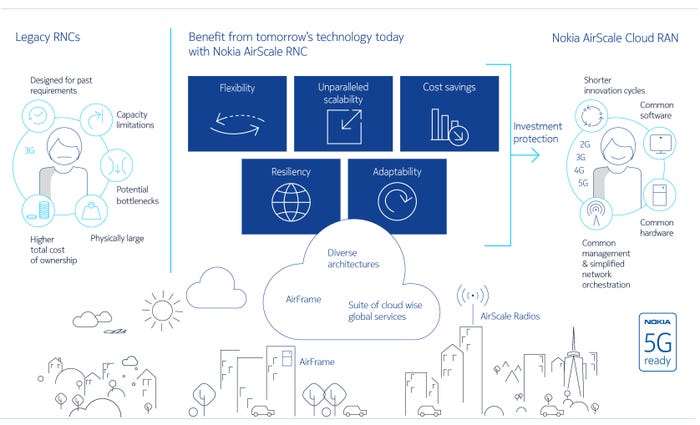As the big network players edge incrementally closer to offering something that can reasonably, with a straight face, be described as 5G, Nokia has given an old launch a new airing.
September 12, 2016

As the big network players edge incrementally closer to offering something that can reasonably, with a straight face, be described as 5G, Nokia has given an old launch a new airing.
AirScale was first unveiled back at MWC in February with heavy use of the already hackneyed term ‘pre-5G’. The cliché had evolved to ‘5G-ready’ by the summer, with Nokia claiming the first such network and moving its buzzword crosshairs towards ‘cloud’. As recently as last week Nokia was banging on about ‘5G acceleration services’, but this is clearly no time for complacency.
The latest increment of progress is an extension of AirScale to make it even more cloudy, which is saying something as it was pretty damn cloudy to start with. As ever with virtualization the result of this new, overcast character is scalability, agility and countless other virtues ending in ‘ility’.
“The journey to 5G can be smoothed by choosing the right technology path,” revealed Frank Weyerich, head of Mobile Networks Products at Nokia. “With 4.5G Pro and cloud-based radio access networks, operators can leverage scalability and flexibility as they start to provide 5G-like use cases on top of LTE, taking user experience to the next level.
“Also, with prime examples such as the launch of the first true cloud-based RNC and the expansion of our AirScale radios and services portfolio, we are showing that Nokia is leading in this space, enabling customers to evolve in the most cost-effective and timely way.”
“We were impressed with the performance of this new virtualised RNC product in the key capabilities tested, in particular its ability to scale capacity to fulfil traffic demand, which will satisfy the future needs of our 3G networks,” acquiesced Arnaud Vamparys, VP Radio Networks and Microwaves at Orange Group. “Based on what we’ve seen this product will perfectly fit in our global mobile access evolution towards virtualisation.”
Hold on, 3G? That’s from, like, 20 years ago. You need to get with the programme Arnaud, all the cool kids are talking about 5G these days. Maybe it was a typo.
SK Telecom seems a bit more up to speed, so much so that it has already implemented a software-defined RAN (SDRAN) in partnership with Nokia. This means the traditional base station functions are virtualised and sit on a regular server, enabling all the aforementioned -ilities.
“This is a major milestone for Nokia; together with SK Telecom, we have for the first time implemented our AirScale Cloud RAN technology in a commercial network,” crowed Weyerich. “We are paving the way towards 5G, and cloud-based radio networks delivering the scalability and flexibility required to allow operators such as SK Telecom to meet the future data demands of customers, enabling new levels of user experience at minimal cost and maximum operational efficiency.”
“Network innovation through convergence of telecommunication and IT is an urgent task to deal with explosive growth of data traffic,” obliged Park Jin-hyo, Head of Network R&D Center at SK Telecom. “SK Telecom will continue to develop innovative technologies like SDRAN to lead the evolution toward next-generation network.”
Some stuff has definitely happened, and everyone seems to agree it was stuff that needed to happen if the big stuff is going to happen. Great start to the week guys. Here’s a diagram of all the 5G/cloud stuff Nokia has on the go right now.

About the Author(s)
You May Also Like








.png?width=300&auto=webp&quality=80&disable=upscale)


_1.jpg?width=300&auto=webp&quality=80&disable=upscale)


.png?width=800&auto=webp&quality=80&disable=upscale)